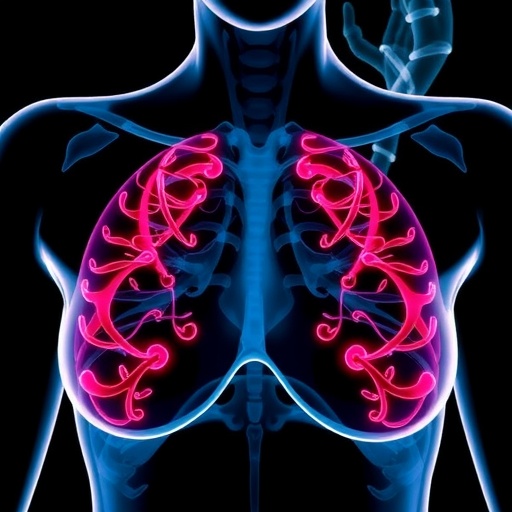In a groundbreaking study encompassing over 100,000 screening mammograms, researchers have illustrated the transformative potential of artificial intelligence (AI) to enhance the early detection of interval breast cancers—those aggressive cancers diagnosed between standard screening intervals. Published in the prestigious journal Radiology, this research spearheaded by experts at the University of Cambridge marks a pivotal advance in personalized breast cancer screening, aiming to minimize the occurrence of interval cancers that tend to portend a poorer prognosis due to their aggressiveness or advanced stage at detection.
Interval breast cancers pose a significant challenge to current screening paradigms because they develop and become clinically detectable within the gaps between routine mammograms. “Interval cancers generally have a worse prognosis compared with screen-detected cancers, primarily because they are either larger or biologically more aggressive,” explains Professor Fiona J. Gilbert, a co-author and radiology professor at Cambridge. Her insights underscore the crucial need for enhanced screening methodologies that can effectively identify women at elevated risk before these cancers manifest clinically.
The study utilized a vast retrospective dataset derived from the United Kingdom’s triennial breast screening program, involving 134,217 digital mammograms performed between 2014 and 2016 across two screening centers equipped with different mammographic systems. This extensive dataset provided an ideal platform to evaluate the efficacy of AI algorithms in stratifying breast cancer risk, particularly focusing on interval cancers that standard protocols might overlook.
Central to this research was the application of Mirai, a sophisticated deep learning-based AI algorithm designed to analyze negative digital mammograms—those without evident cancer—and generate a comprehensive risk score predicting an individual’s likelihood of developing interval breast cancer within the subsequent three years. Mirai evaluates complex mammographic features, including tumor morphology and breast density, which are critical indicators that conventional risk tools often inadequately assess.
The AI model demonstrated a remarkable predictive capacity, identifying 42.4% of the 524 interval cancers within the cohort when focusing on women who scored within the highest 20% risk bracket. Specifically, among women in the top 1%, 5%, 10%, and 20% risk categories, Mirai retrospectively predicted 3.6%, 14.5%, 26.1%, and 42.4% of interval cancers, respectively. This stratification translates into a meaningful increase in cancer detection rates, effectively enabling targeted supplemental imaging interventions for the women at greatest risk.
Dr. Joshua W. D. Rothwell, the study’s lead researcher, emphasized the potential clinical implications, stating that focusing follow-up efforts on the top 20% of high-risk mammograms could identify nearly half of all interval cancers. This approach would allow for tailored supplemental imaging techniques—such as magnetic resonance imaging (MRI) or contrast-enhanced mammography—potentially revolutionizing screening schedules by shifting from a uniform triennial model to more personalized, risk-adaptive algorithms.
One notable finding was that Mirai’s predictive performance was most robust within the first year following a negative mammogram, with diminished accuracy extending into the subsequent two years. While the AI showed some limitations in women with extremely dense breast tissue—where mammographic visualization is inherently challenging—it still outperformed existing conventional risk models, highlighting AI’s promise to augment human clinical judgment.
Given the United Kingdom screens approximately 2.2 million women annually through its national breast screening program, integrating AI risk stratification could significantly optimize healthcare resources. However, logistical considerations remain paramount as calling back 20% of screened women for advanced supplemental imaging would necessitate a substantial expansion in MRI and contrast-enhanced mammography capacity, potentially impacting service delivery and cost-effectiveness.
The researchers have outlined their forthcoming objectives, which include comparative studies of commercially available AI predictive tools, detailed economic modeling, cost-effectiveness analyses, and prospective clinical trials to evaluate patient outcomes when AI-guided supplemental imaging is implemented. These efforts aim to validate and refine AI’s role in real-world screening environments, ensuring that its application improves early cancer detection without overwhelming healthcare infrastructure.
At its core, this study exemplifies the evolving complexity in breast cancer risk identification, combining multifactorial clinical data with cutting-edge machine learning technologies to illuminate subtle mammographic cues indicative of future cancer development. “Accurately identifying those women most likely to develop interval cancers while judiciously limiting unnecessary supplemental imaging is the ultimate objective,” states Professor Gilbert, underscoring the delicate balance between precision medicine and healthcare pragmatism.
This research heralds a new era where AI serves as a vital tool, enhancing radiologists’ capabilities and enabling a paradigm shift toward more dynamic, individualized breast cancer screening protocols. By integrating comprehensive mammographic analysis with predictive modeling, AI has the potential to significantly reduce diagnostic delays, improve prognoses, and ultimately save lives.
The impact of this AI-driven approach extends beyond technology, touching on important ethical, logistical, and economic considerations as healthcare systems worldwide grapple with rising cancer incidence and finite resources. Future developments will need to carefully navigate these challenges, ensuring that AI adoption enhances equity in healthcare access and outcomes without exacerbating disparities.
As AI technologies continue to mature and integrate seamlessly with clinical workflows, their role in cancer screening will likely expand, encompassing other imaging modalities and tumor types. This study represents a vital milestone in demonstrating the tangible benefits of deep learning models when applied to large-scale, real-world screening data, paving the way for broader acceptance and clinical implementation.
With the Radiological Society of North America spearheading this innovative research, the promise of AI to revolutionize breast cancer detection is becoming a reality. Continued interdisciplinary collaboration among radiologists, data scientists, healthcare policymakers, and patient advocates will be essential to fully realize AI’s transformative potential in cancer prevention and early diagnosis.
Subject of Research: People
Article Title: Evaluation of a Mammography-based Deep Learning Model for Breast Cancer Risk Prediction in a Triennial Screening Program
News Publication Date: 28-Oct-2025
Web References: https://pubs.rsna.org/journal/radiology, https://www.rsna.org/
References: Gilbert F.J., Rothwell J.W.D., et al. “Evaluation of a Mammography-based Deep Learning Model for Breast Cancer Risk Prediction in a Triennial Screening Program,” Radiology, 2025.
Keywords: Breast cancer, Artificial intelligence, Mammography




